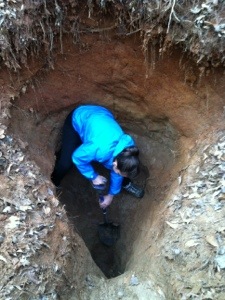I initiated spring break with three of my best friends by traveling about an hour away to go try to find some rubies and sapphires. The corundum in the particular area we visited is mostly of a pink color, thereby qualifying it as pink sapphire rather than red ruby. The red rubies were our main target for today’s trip, however. Another friend had success at this location earlier in January and told me about the spot, thereby sparking my interest in visiting this area to try to find my own corundum. My friends have never been out to find their own gemstones, so I was really hoping that we would find some so they would have a good time.
The corundum crystals in this area are found in weathered remnants of pegmatite. Think of a pegmatite as granite with much larger crystals making up its composition. Pegmatites are very similar to granites with respect to how their compositions are often quite varied. A pegmatite predominantly consists of feldspar, mica, and quartz. Therefore, it makes sense for the corundum crystals in this area to be found near veins of quartz. Additionally, Jenna and Marissa noted how beautiful the shiny flakes in the soil we dug up were today. I would guess that these flakes were of mica even if I had not known about the corundum crystals being found in a pegmatite just from their consistency in the soil.
I would post the name of the area we went to if it seemed worth it to ever go back there to search more…but it was absolutely not worth it. To put it simply, it was just a wreck. It was nothing like I expected it to be. The area we were digging in was typical North Carolina red clay. I expected that. The rains from earlier this week made the soil pretty manageable. I expected that. What I did not expect was having a twelve foot deep pit in the ground dug (backbreaking work) without coming across a single rock. We did not even find a single piece of quartz here either. My friend who found a sapphire in this area in January found a lot of quartz which served as an indicator of becoming close to the corundum vein. I could go dig through the red clay in my backyard and find quartz. Quartz is very common in the soils of the Piedmont.
So much of what I read online about this spot emphasized that there would be a rock layer about nine or ten feet deep which held the corundum we hoped to find. There is a small stream which flows along this property, so I hoped that rock layer would be at a depth of about nine feet as the online resources emphasized. Well, we did not find it. Jenna commented that she liked how the soil layers changed color because we were not finding anything else in our pit. Once we got about nine feet deep in our pit we were becoming very discouraged. We did our homework before setting out to start searching for corundum crystals today. What baffles me is that the soil in this particular area did not have even a single piece of weathered rock in it. This was such a bummer.
 The look on my roommate Jenna’s face when I pulled out our gear was pretty priceless. Here she is hard at work!
The look on my roommate Jenna’s face when I pulled out our gear was pretty priceless. Here she is hard at work!